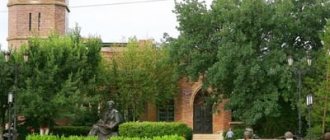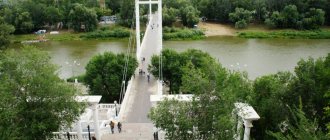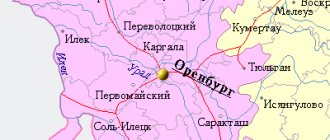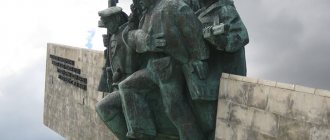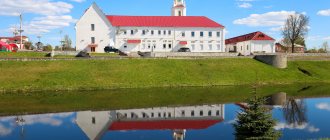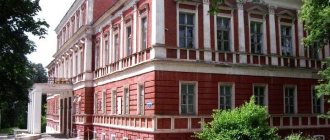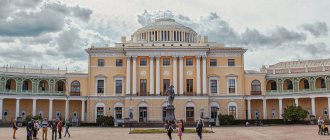Methodological development “Historical buildings of Orenburg”
Historical
building
V
Orenburg
Sovetskaya, 1
The second half of the 19th century was a period of stylization. At this time, the number of floors increased even in provincial Orenburg, although the buildings generally did not go beyond two floors. In the seventies, the first five-story building in the city appeared (Sovetskaya, 1). It was built for a military educational institution and is designed for living quarters and classrooms.
Sovetskaya, 32
House 32 on Sovetskaya Street, built in the mid-seventies of the 18th century, saw many outstanding people within its walls. This typical provincial mansion is also interesting because it, built during the period of classicism, deviates from the rules of the latter and instead of window openings and doors along the axis of symmetry of the main facade has piers. This house is from 1833-1841. It was filmed by military governor V.A. Perovsky, a very extraordinary person. V. I. Dal and many others, perhaps A. S. Pushkin, visited him here more than once on business and on business.
Elizabeth Gate
This low stone gate made of plastered brick is installed in front of the reconstructed historical descent to the Ural River. The gate is crowned with a bas-relief depicting the state emblem of the Russian Empire surrounded by military paraphernalia - banners, axes, guns and cannonballs. In the middle of the coat of arms are the initials of Empress Elizabeth and the date - 1755. In addition to these decorations, two angels are installed in the niches on both sides of the gate, holding a shield and a palm branch in their hands. This gate is a reconstruction of the ancient gate of the city rampart, called the Water or Elizabeth gate. The city received them as the highest gift from Empress Elizabeth Petrovna to the governor of the Orenburg region I.I. Neplyuev as a reward for suppressing the Bashkir rebellion. Initially, the gate was installed at the site of the modern intersection of Burzyantsev and Maxim Gorky streets, near the road from the city to Menovaya Dvor. Subsequently, it was postponed several times. In 2008, the Elizabeth Gate was restored on its historical foundation using surviving drawings and photographs. The bas-reliefs that decorated the gates were preserved, but for safety reasons they were replaced with exact copies.
Some old-timers said that these gates had magical powers - as soon as a guy took a photo under them with his beloved, victory awaited him - the girl would definitely become his wife.
Gostiny Dvor in Orenburg
Gostiny Dvor
- a characteristic monument of commercial origin
Gostiny Dvor
is located in the center of Orenburg - between Sovetskaya, Kirov, 9th January and Pushkinskaya streets. Currently there is a shopping complex here.
Gostiny Dvor
began to be built almost simultaneously with the city of Orenburg. Its length was 104 fathoms and its width was 94 fathoms. The main architect and builder was Johann Werner Müller.
It was a beautiful building for that time.
Gostiny Dvor
was a fortress: it was surrounded by a high stone wall. An ancient tower still rises above the western gate. Inside there were 150 shops and barns. Vaults and canopies over the shops made it possible to trade in any weather. Gradually, the Gostiny Dvor was remodeled so that the doors and windows of the shops began to open onto the street.
Gostiny Dvor
served as a place for winter trade. However, the busiest trade was in the summer, since in winter the Kazakhs went to the distant steppes for the winter.
In the corners of Gostiny Dvor
had four bastions. The remains, or rather the locations of these bastions, can still be seen today.
Museum of Orenburg History
The museum building was erected in 1856, designed by architect Skalochkin, style - late Gothic. The museum building looks very much like a medieval castle. The museum was opened for the 240th anniversary of the city of Orenburg in April 1983. The museum includes four branches: the Memorial Museum-Guardhouse of Taras Shevchenko, the Museum-Apartment of Yuri and Valentina Gagarin, the House of Memory, and the Memorial Museum-Apartment of the Rostropovich Family.
Oreburg Museum of Local Lore
The beautiful building of the regional museum of local lore (Orenburg, Sovetskaya street, 28) was built in 1831. The building was built in the style of late classicism. All its facades, except for the courtyard, are formal. The central portico of the Ionic order stands out, which is raised to the mezzanine level and rests on the arcade. The museum is located in the mansion of the merchant Yenikutsev, an architectural monument of the 19th century.
After the October Revolution, this building housed various party and Soviet institutions. Regional Museum of Local Lore
has been here since 1946.
The museum's funds contain the most valuable books on the history and economy of our region, exhibits of national importance: the banner and certificate of the All-Russian Central Executive Committee, awarded to Orenburg workers for the heroic defense of Orenburg in 1919. The plaster mask of the greatest Russian poet A.S. Pushkin (one of three in existence) is carefully kept here. It was removed from Pushkin’s face by the writer V.I. Dahl and brought to Orenburg. In the halls of the museum there is exhibited a cannon made by Ural workers for Pugachev, original decrees of Pugachev, wonderful paintings by the Itinerant artist Lukian Vasilyevich Popov and many other exhibits.
Among the collections of the nature department are samples of minerals discovered in the Orenburg region - ores, oil, various salts, ornamental stones and building materials. Photographs and diaramas, stuffed animals, various models and dummies - all this helps visitors get a clear idea of the Orenburg region in all its diversity. The collections of the local history museum are systematically replenished. Its workers annually conduct archaeological, archaeographic, ethnographic and other expeditions.
Guardhouse
This building is in Orenburg on the street. Soviet, was built in 1843.
For some reason, this building, standing above the steep cliff of the Urals, is called a “fortress” by many. Obviously, for the unique architecture and decorative tower, narrow windows, vaguely reminiscent of loopholes. But this is not a fortress. The building was originally intended to store the governor general's archives and securities, but was adapted for a guardhouse. For more than a hundred years, violators of military discipline of the Orenburg garrison served here the “term established by the commander.” Among the cadets of our military schools there was an unwritten law - if you leave the “lip” - sign on one of its stones! Until recently, one could read the names of its former “guests” on the bricks of the end wall. On April 27, 1851, the arrested poet and artist Taras Grigorievich Shevchenko was placed here.
Nowadays, the museum of the city of Orenburg is located here. But he did not get here right away - after lengthy negotiations with the military department.
Guardhouse
is interesting for its tower, not so much for the tower as for the history associated with the clock that was once installed on it. Their musical chime, every half hour, carries far away from the steep bank of the Urals, fading somewhere in the Asian distance.
Over time, it was rebuilt - and not in the best way: the building is not at all painted by the windows broken into the mezzanine floor on the front facades, the portico with a balcony, the belvedere on the roof and a number of other elements and details were lost.
House of Officers
Today it is difficult to imagine Sovetskaya Street without the original turret that crowns the corner bay window of the House of Officers. Before the revolution, this huge building, owned by the merchant Troshchin, was an entertainment center. There was a cinema "Olympus", a spacious restaurant, a confectionery and coffee shop "Cake", five billiard rooms and much more. The building is in Art Nouveau style.
Belovka
Builders of the Orenburg
They erected a redant on the high bank of the Urals - an open area without a rampart or ditch, protected from the enemy only by a coastal cliff.
In 1857, the redant was turned into a boulevard, the first trees were planted, and a pavilion for a buffet was built. Flowerbeds and fountains appeared. The local merchant Belov built a light building called the Station, where music was played in the evenings. Since then, the boulevard named after Ya.M. Sverdlov, called Belovka
.
In the sultry steppe a fortress was built, and a city was built. It was painful for its residents to endure the time when there was no escape from the heat and dust, when the sand crunched in their teeth... The military governor Count of Essen was the first to decide to enter into battle with nature - he demanded that all homeowners have a front garden in front of their house, and each resident was male , starting from the age of twelve, plant a certain number of trees and care for them. He monitored the execution of his orders very strictly. But it was difficult to grow trees - the city did not have enough water. Essen even thought about installing a water supply system...
Exhausted by the heat and dust, residents were drawn to the river, to the life-giving coolness, to the Trans-Ural Grove
.
But it was not landscaped. Essen orders engineer Major General Bikbulatov to lead the reconstruction of the Trans-Ural Grove - to lay alleys, replant trees, select and improve places for public beaches. Through his efforts, the Transural Grove
soon becomes the favorite vacation spot of the townspeople. And for many years, on weekends and holidays, the music of military bands sounded here, and visitors were entertained by specially selected soldier songwriters. Every summer, the European coast was connected to the Asian coast by a narrow pile bridge. A bathing area was built next to the bridge, and pleasure boats were also available here. From the wide alley leading to the Big Glade, a whole network of smaller ones was laid. And all of them were regularly sprinkled with sand by the soldiers. Along the Staritsa, which has survived to this day, there is an alley lined with trees that, according to legend, were planted during the reign of Essen. The steep, steep bank also underwent reconstruction - a steep descent-staircase was made along it to the Urals. A little to the left, straight from the Elizabethan Gate, there was a staircase, consisting of separate flights of six to eight steps and intermediate platforms between them for rest. The remains of this descent, heavily damaged and cluttered, remain to this day. During the Great Patriotic War, it was still among those active. Women and children, heavily laden with gifts from melon and potato plots, climbed up the mountain along it. Parallel to these stairs, a little to the right, there was a pedestrian path along which cyclists pulled their garden luggage up.
The embankment has also been reconstructed several times. Merchant Belov, an almost illiterate man, but exceptionally smart and enterprising, laid out flower beds; next to the old descent, at the Elizabeth Gate, he erected a gazebo pavilion where soft drinks were sold. He built a restaurant on stilts, right above the steep bank. And things worked out for him! Directly from the restaurant, he laid another gentle slope without steps, which snaked almost to the river.
Currently, in the center of the boulevard there is a monument to V.P. Chkalov, in the depths of the alley, on a concrete pedestal - a memorial cannon, a beautiful embankment, a pedestrian bridge over the river, cabins on the cable car. The center of the boulevard turns into a descent to the Ural River. A staircase with columns and gazebos leads to a pedestrian bridge connecting the city with the largest recreation area - the Transural Grove. Under the steep right bank of the Urals there is a miniature railway station, from which trains depart exactly on schedule. This is a children's railway: children have been traveling on it and serving it since 1953. The railway leads to the Dubki pioneer camp area.
Gazebo-rotunda in Leninsky Square
A typical building of landscape architecture in the style of classicism is the rotunda gazebo in Orenburg. Most likely, it was built in 1829 in the Trans-Ural Grove during the reign of military governor P.K. Essen, who had a passion for gardens and parks.
Paths were laid in the grove and wooden gazebos were built. On holidays, an orchestra played and fireworks were displayed.
The rotunda is a typical element of park buildings of the Classical era.
The gazebo was built, presumably, according to the design of the architect Alfeev. In the 1890s, the gazebo was moved to Aleksandrovsky Square (now V.I. Lenin Square). In the center of the gazebo there used to be a fountain with a figure of cupid, now lost.
Water tower
In 1904, an original building appeared at the intersection of Zhukov and Pobeda avenues. It was intended for water purification in the city and had a volume of more than 80 buckets. Although the volume is small, the very fact of the appearance of such a tower in the city and providing residents with drinking water was the first step towards industrialization and development of the economy of the city and region.
Today it is a historical monument of Orenburg and a landmark of the city. The picturesque tower building is located in a historical area; it used to be surrounded by one-story residential buildings; there was a stone mill behind the water tower until 1939.
Now next to the tower there are: the Orenburg Regional Philharmonic, a television center and, in architectural contrast, a library building. When the intersection and the tower building are illuminated at night, this part of the city becomes unusual and interesting for tourists.
Currently, the building houses various commercial structures.
Caravanserai
The Orenburg Caravanserai was built at the expense of ordinary people from 1837 to 1846, the author of the project is A. P. Bryullov.
It is a complex architectural work, which consists of a main building, a minaret and a mosque. Only at the beginning of construction it was located on the outskirts of the city; now it is the central part, surrounded by residential buildings. But the main work was completed in 1842 and another 4 years were spent on finishing external and internal work.
The date of the grand opening of the caravanserai is 1846.
Initially, it was assumed that the main building would be occupied by the apartments of the commander of the Bashkir army, as well as a hotel for Bashkirs coming to Orenburg on business. In addition, there were plans to establish a school here with various workshops for Bashkir children. In 1865, the Bashkirs put forward demands for the return of the Caravanserai, built at their expense and by themselves. But it was returned only in 1918. In 1921, the Bashkir Pedagogical College opened here; in 1924, the complex was given to the Orenburg province. Since 1960, it has been considered an architectural monument and is under state protection.
Train Station
As they say, “The theater begins with a coat rack, and the city begins with a station.” The station in Orenburg is one of the most beautiful in our area. It was made in the spirit of St. Petersburg architecture. It was opened on December 31, 1876.
Museum of Local Lore
The local history museum in Orenburg is the oldest in Russia. Its foundation is considered to be 1830 . The museum is located in a very beautiful building - the former governor's office. Inside you can see restored interiors of the 19th century, so the halls themselves are interesting to visit. This magnificent frame is complemented by pearls from museum collections.
Here you can see:
- Award checkers for the Orenburg Cossacks.
- Cannon of the Pugachev army.
- One of the four death masks of A. S. Pushkin.
- Gold jewelry from the Sarmatian royal tombs.
There are more than 100 thousand exhibits in the museum. But to fully get acquainted with the region, only one thing is missing - an Orenburg down scarf. You can learn about its history in the nearby Museum.
Address: Sovetskaya street - 28.
Monument to the water supply
Orenburg's unusual monuments also attract city guests. An original art object depicting an ancient water standpipe, immortalizing the history of the first city water supply system, opened on the eve of the 270th anniversary of Orenburg in a public garden located behind the drama theater.
There was a leak at this location several years ago. The specialists involved in the repair work, to their surprise, discovered a rather large fragment of a wooden pipe that had been laid in the 19th century.
Art Museum
There is a unique collection of scarves, the oldest of which is more than 100 years old. It weighs only 40 g. The Orenburg down scarf owes its appearance to Cossack women. They started knitting it at the end of the 18th century. The Cossacks quickly brought their skills to perfection. The fluff of local goats was so delicate and thin that products made from it could easily be placed in the shell of a goose egg and passed through a wedding ring.
Openwork spider webs received high awards at all international exhibitions. They were also coveted gifts for the imperial families of Europe. And today a down scarf is the most popular souvenir from Orenburg.
Address: Kashirina Lane-29.
Caravanserai
One of the most remarkable architectural monuments of Orenburg is the Caravanserai. Its construction began in the spring of 1838. The Caravanserai was supposed to become a place of refuge for the Bashkirs and other peoples of Central Asia, and also serve to strengthen international ties.
The architectural complex included the main building, a mosque, a minaret and outbuildings. The specifics of the building are determined by the national Bashkir flavor, which has been preserved to this day.
Address: Parkovy Prospekt street - 6/1.
Paragliders
In the city where the famous Chkalov flight school was located, and Gagarin made his first airplane flight, residents and guests continue to conquer the skies.
Paragliding is a way to fulfill your dream of soaring to the clouds. In Orenburg, ideal conditions for paragliding are:
- The weather is always clear.
- Constant strong wind.
- A large number of grass covered slides.
Even those who are afraid of heights and paragliding will be delighted by the stunning spectacle.
From the history of the city
Probably, in the vast expanses of Russia there is no second city with such an unusual history: Orenburg was founded three times, four times it was a provincial and regional city, three times it was a district city, its name also changed three times. The city even had the status of the capital of Kazakhstan (1920-1925).
In the fall of 1735, the first fortress was founded on the land where the Ori River flowed into Yaik. However, the place was chosen extremely poorly - the fortress was constantly flooded with spring waters. In August 1739, it was moved to the town of Krasnaya Gora, located downstream of the Yaik. The city was founded for the third time on April 19, 1743 in its current location.
In 1938, Orenburg was renamed Chkalov in honor of the legendary Soviet pilot, who, however, had nothing to do with the city. In 1957, the city returned its historical name - Orenburg. The impetus for its rapid development was the discovery of a gas field in the seventies of the last century. Today Orenburg is a comfortable modern city with developed industry and infrastructure.
House on Sovetskaya
This building on Sovetskaya Street, 36 attracts attention not only with its architecture, but also with the message left on it. Three letters - PFP and the number - 1914. What do they mean? The fact is that a little over 100 years ago the building was built on the initiative of the merchant of the 1st guild Pyotr Fedorovich Pankratov.
In the spring of 1914, a message appeared in local newspapers that a new cinema called the Apollo Theater was currently being built by the merchant Pankratov on Nikolaevskaya Street. The cinema was opened in September of the same year. In memory of this, the merchant's initials and the year of completion of construction appeared in glazed tiles on the façade.
Pankratov was a prominent businessman in Orenburg and enjoyed obvious authority and respect from his colleagues. He was the owner of a large trading house. Nowadays this building is on Matrossky Lane, 7.
At the intersection of Kirov and Sovetskaya streets there is a large apartment building of Pankratov , whose apartments were rented out.
Orenburg downy shawl
The legendary down products are still knitted throughout the region. Each village has its own secrets and traditions that are passed on from generation to generation. The process of making an Orenburg scarf has remained virtually unchanged for hundreds of years.
As before, goats are scratched in winter. Then the hairs are selected so that the product does not prick. After this, the fluff is combed. Down thread is spun by hand using a spindle.
It will take a month to knit a good scarf. After knitting, it is washed and carefully stretched on special frames for each clove. When it is completely dry and takes shape, the scarf will be sent to the buyer.
It is best to buy scarves at local markets. From early morning, crowds gather here wanting to sell and buy something downy: mittens, scarves, socks, stoles and, of course, scarves. They are available in the market in all shapes, sizes and colors. The main rule when buying: you need to choose a scarf by touch. Unlike the shaggy Volgograd and prickly Angora, Orenburg down should be soft and warm.
Another important criterion will be price. The starting price of stoles is 700 rubles , warm scarves – from 1500 , designer webs can reach several tens of thousands of rubles. In any case, no one leaves Orenburg without a downy miracle. Unlike other souvenirs, this item is useful and practical.
House of the Noble Assembly
The House of Noble Assembly was erected under the governorship of Vasily Alekseevich Perovsky. On December 2, 1841, its grand opening took place. On this occasion, a brilliant ball was given, no worse than in St. Petersburg.
This building is an example of the highest art, the harmonious style of late classicism, which dominated from the beginning of the 19th century in Europe and the Russian Empire.
Address: Sovetskaya street - 17.



